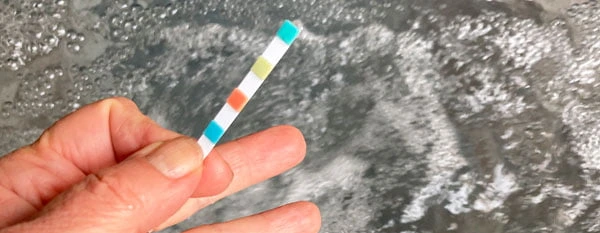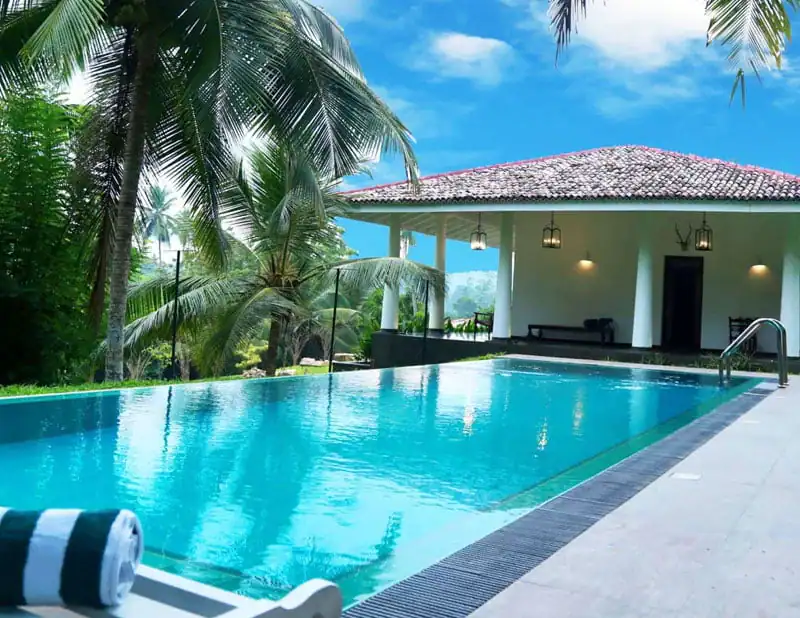Many pool owners have wondered about converting a their swimming pool into a saltwater pool and if it’s worth the cost and the hassle to do so. What are the considerations of a chlorine to saltwater pool conversion?
One of the main advantages of a saltwater pool is that the water is softer and gentler on the skin and eyes. The saltwater also stabilizes the pH level of the pool, reducing the need for frequent adjustments.
However, it’s important to note that a chlorine to saltwater pool conversion does come with some costs and will have impacts on your maintenance routine that pool owners should be aware of before making the switch.
What is a Saltwater Pool?
A saltwater pool is a type of swimming pool that uses salt to generate chlorine instead of adding chlorine directly to the water.
The saltwater pool system uses a salt cell or a salt chlorine generator to convert the salt in the water into chlorine. The chlorine generated by the salt cell is milder and less irritating to the skin and eyes compared to the chlorine used in traditional chlorine pools.
A chlorine to saltwater pool conversion requires the addition of pool-grade salt to the water. This salt is different from table salt or sea salt and is specifically designed for use in swimming pools. Also, the amount of salt used for the Chlorine generator is a much lower level of salt than you get with ocean water – about 10% as much salt.
The salt cell generates chlorine by electrolysis, which breaks down the salt molecules into sodium and chlorine. The chlorine that is produced by the salt cell kills bacteria and other harmful organisms in the pool water. If you want to know more about how and why that works, see this article on Electro-chlorination.
It is important to note that a saltwater pool is not a chlorine-free pool. The saltwater pool system generates chlorine, but the levels of chlorine are typically lower than in traditional chlorine pools.
The saltwater pool also requires regular testing and maintenance of the water chemistry to ensure proper balance of pH, total alkalinity, calcium hardness, and salinity levels. For more details about pool maintenance and water testing for Saltwater pools, see our article Saltwater Pools: How Much Salt For Proper Chlorination?
If the water chemistry is not properly balanced, it can lead to problems such as high levels of chloramines or scaling caused by high levels of calcium.

Converting A Swimming Pool To A Saltwater Pool
So – what’s involved in a Chlorine to Saltwater pool conversion?
Costs of Converting to a Saltwater Pool
On average, the cost of converting a swimming pool can range from $1,500 to $3,500. This cost includes the installation of a salt system, a chlorinator controller, a chlorinator cell and the first batch of salt.
Converting a chlorine pool to a saltwater pool can be expensive. The cost can vary depending on the size of the pool, the type of equipment needed, and the amount of work required. Additionally, the pool equipment may need to be upgraded to accommodate the new system.
Is a Chlorine to Saltwater Pool Conversion a Good DIY Project?
People who love DIY and are REALLY good at plumbing might undertake a project like this themselves, but most people opt to have a qualified pool installation contractor provide this service. Also note that salt chlorine generators require electricity, so if a source of line power is not close to where you want to install the salt cell, DIYers need to also be adept at doing electrical work safely.
Installation Process
The installation process for converting a chlorine to saltwater pool conversion typically takes about a day or two.
- While it isn’t required, the project will go more smoothly if you start with balanced pool water: pH and alkalinity are the most important things.
- Turn off the entire pool system and drain down the plumbing system including the pump and filtration system. The pool does not need to be drained. You are just changing the source of the chlorine – there is nothing wrong with the water in your pool.
- The new salt chlorinator system is then installed, along with the chlorinator controller, the salt cell and whatever sensors the salt chlorine generator kit comes with. Note that these systems are based on electrolysis, so a source of electricity needs to be nearby. In other words, the system will probably get installed somewhere near where your pumps are.
- After the new plumbing has been tested (no leaks, no flow problems), the correct amount of salt gets added to your pool water and the pumps/jets should be run until the salt is mixed throughly. If you are wondering how much salt you need for the initial startup, see our Pool Salt Calculator.
- Re-test all your water quality levels and tweak anything that needs adjusting. All done! Go jump in the pool!
When doing a chlorine to saltwater pool conversion it’s important to remember that pool-grade salt must be used for the conversion process.
Pros and Cons of Saltwater Pools
Many pool owners consider converting their traditional chlorinated pools to saltwater pools. While saltwater pools have some advantages, they also have some disadvantages. This section will discuss the pros and cons of saltwater pools.
Pros of Saltwater Pools
Here are some of the benefits of saltwater pools:
- Comfort: Swimmers tend to notice that the water in saltwater pools tends to be less irritating to their skin and eyes than pools that must be treated with added chlorine.
- No Chlorine Smell: Saltwater pools use a salt chlorination system to generate chlorine, which results in a milder and more pleasant smell compared to chlorinated pools. The salt cell produces a steady supply of free chlorine, instead of needing to periodically add chlorine.
- Reduced Chemical Costs: Salt chlorination systems require less maintenance and fewer chemicals, which can save pool owners money in the long run. Once the salt is initially added to the pool, the salt level tends to stay stable. You will only occasionally need to add salt in the case where saltwater leaves the pool (splashing, backwashing filters).
- Chlorine Level Stability: Since the salt cell is producing chlorine whenever the pumps are running, you will observe a more stable available chlorine level as compared to periodically adding Chlorine to the system.
Cons of Saltwater Pools
Here are some of the disadvantages of saltwater pools:
- Salt Chlorine Generator: Saltwater pools require a salt chlorine generator (also called a Salt Cell), which can be expensive to install. Depending on your water source and how often your pool gets used, the salt cell occasionally needs maintenance and tend to have a lifespan of 3 to 7 years before replacement.
- Initial Cost of the Salt: When first filling the pool, you must buy and add salt. Even a small pool (about 10,000 gallons) needs about 270 pounds of salt the first time. See the Pool Salt Calculator to estimate how much salt you would need for your pool in this article: The saltwater pool also requires regular testing and maintenance of the water chemistry to ensure proper balance of pH, total alkalinity, calcium hardness, and salinity levels. For more details about pool maintenance and water testing for Saltwater pools, see our article Saltwater Pools: How Much Salt For Proper Chlorination?
- Pool Size: Saltwater pools require a larger initial investment than chlorinated pools, which may not be feasible for some pool owners.
- Corrosive Power of Salt: Saltwater, even at very low concentrations can be corrosive when used with a concrete pool. Saltwater systems are generally only recommended for fiberglass pools and pools with liners.

Maintaining a Saltwater Pool
We’ve devoted an entire article that focuses on Saltwater pool maintenance and water testing, so please see our article Saltwater Pools: How Much Salt For Proper Chlorination? This article also contains a Pool Salt Calculator so that you can figure out how much salt you initially need to set up your Salt Chlorine Generator, or how much salt you need to add just to balance a pool that is already running a salt cell system.
Is It Worth Doing a Chlorine to Saltwater Pool Conversion?
There are numerous benefits to converting a swimming pool to a saltwater pool. Not only do saltwater pools provide a more natural swimming experience, but they are also easier to maintain and more cost-effective in the long run.
- Gentler Swimming Experience – The water in a saltwater pool is softer and silkier than the water in a traditional chlorine pool, which can be harsh on the skin and eyes. This means that you and your family can swim comfortably for longer periods of time without experiencing discomfort. You may notice that you are slightly more buoyant – although only 10% of the salt as compared to ocean water, you may float just a bit easier.
- Less Maintenance – With a saltwater system, you won’t have to worry about adding chlorine tablets or shock treatments to the water. Instead, the saltwater generator will automatically produce the necessary amount of chlorine to keep the water clean and clear. This means less time spent maintaining your pool and more time enjoying it.
- Cost-Effective – While the initial cost of installing a saltwater system may be higher than that of a traditional chlorine system, the ongoing maintenance costs are significantly lower. This is because you won’t have to constantly purchase and add chlorine tablets to the water. Over time, this can add up to substantial savings.
Final Thoughts
Undertaking a traditional chlorine to saltwater pool conversion has numerous benefits that make it a worthwhile investment for pool owners.
Saltwater pools provide a more natural swimming experience with softer, silkier water that is gentle on the skin and eyes. They also require less maintenance and are more cost-effective in the long run, despite the higher initial cost of installation. By making the switch to a saltwater pool, pool owners can enjoy a more comfortable and enjoyable swimming experience while also reducing their environmental impact.
With the help of a professional pool service, converting a pool to a saltwater system can be a relatively simple and stress-free process that will ultimately pay off in terms of improved water quality, reduced maintenance, and long-term cost savings.







